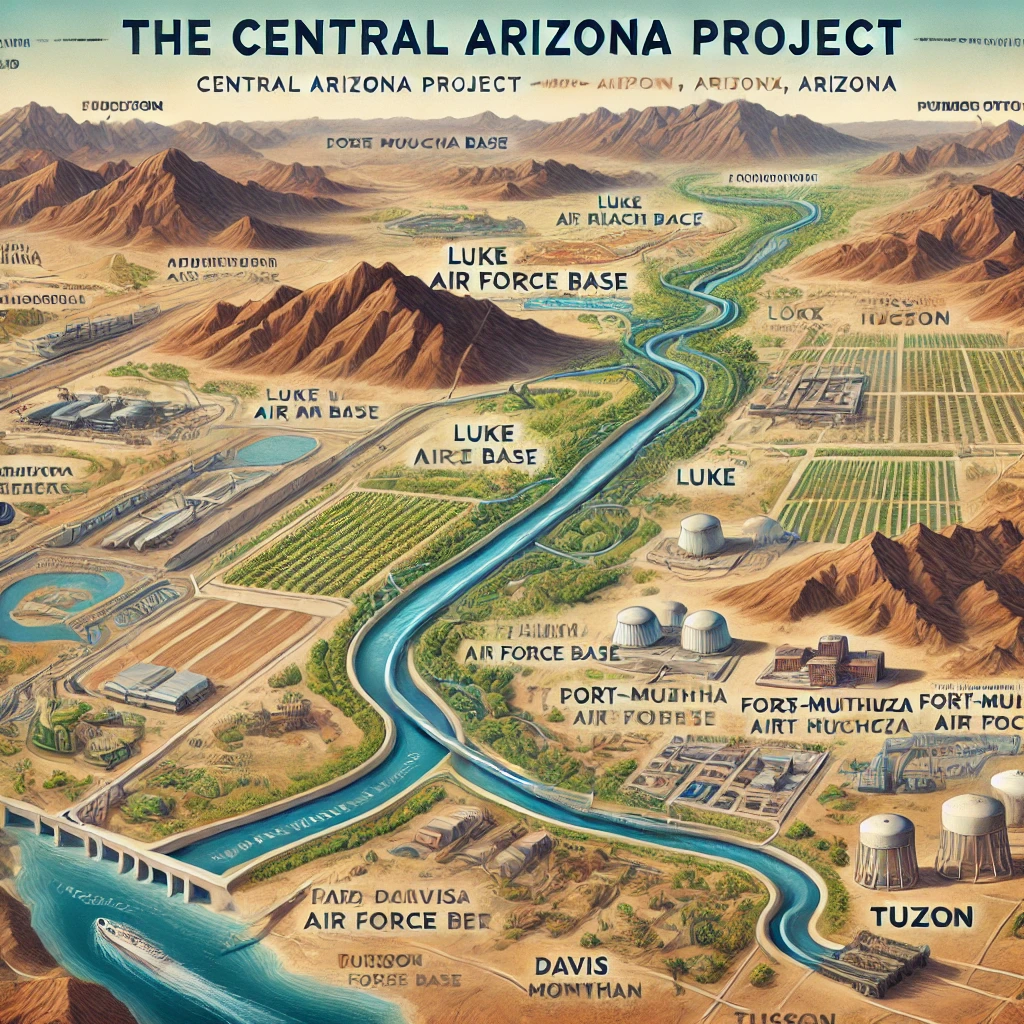The Central Arizona Project (CAP) is one of the most significant water infrastructure initiatives in the American Southwest, delivering water from the Colorado River to central and southern Arizona. While the CAP is often discussed in terms of economic development and water resource management, its origins and federal support are also deeply rooted in national security and political strategy. This post explores how the federal government used the CAP as a tool to reinforce national security and secure political benefits, ensuring stability and growth in a critical region of the United States.
National Security: A Primary Driver for the Central Arizona Project
The federal government’s investment in the CAP was motivated not only by the need to secure water for Arizona’s growing population and economy but also by strategic national security considerations. The Southwest, particularly Arizona, is a region of critical importance, given its proximity to the U.S.-Mexico border, its military installations, and its growing defense industries. Ensuring a stable and water-secure Arizona was seen as essential for maintaining control and stability in the region.
1. Strategic Location Near the U.S.-Mexico Border
- Buffer Against Instability: Arizona’s proximity to the U.S.-Mexico border made it a region of strategic interest for national security. The CAP was instrumental in building a resilient and economically stable region that could act as a buffer zone against any potential instability or conflict along the border. By providing a reliable water source, the federal government aimed to support urban and agricultural development, ensuring that the region remained secure and productive.
- Border Security and Infrastructure Development: With the CAP, the federal government ensured that Arizona’s growing population and urban centers had the resources needed to support effective border security measures. A well-developed Arizona provided a stable environment for federal agencies, such as Customs and Border Protection (CBP) and the Department of Homeland Security (DHS), to operate effectively in securing the border.
2. Supporting Military Installations and Defense Operations
- Water for Military Bases: Arizona hosts several critical military installations, including Luke Air Force Base, Davis-Monthan Air Force Base, and Fort Huachuca. These bases play vital roles in U.S. defense, from fighter jet operations to surveillance and intelligence missions. A secure and reliable water supply from the CAP was essential to maintain these bases and support their operational capabilities.
- Logistical and Community Support: Military installations depend heavily on local communities for logistics, housing, and essential services. The CAP ensured that these communities had the infrastructure to support the military population and their families. By stabilizing the local population through a dependable water source, the federal government reinforced Arizona’s role as a strategic hub for defense operations.
3. Ensuring Long-term Regional Stability in the Southwest
- Building a Resilient Region: The Southwest, particularly Arizona, is strategically located between California and the Mexican border. By investing in the CAP, the federal government aimed to stabilize the region economically and demographically, ensuring it remained a reliable and resilient area. Water scarcity or economic decline could weaken this strategic zone, leading to migration, population decline, or conflicts over resources—all scenarios that could compromise national security.
- Geopolitical Leverage: The CAP’s role in securing Arizona’s water allocation from the Colorado River also strengthened the federal government’s geopolitical leverage in managing the region. By ensuring that Arizona could access its share of water, the federal government maintained control over the development and stability of the region, preventing resource scarcity from becoming a source of dispute or crisis.
4. Supporting Population Growth and Economic Development for Defense Readiness
- Promoting Urban Growth: A growing population in Arizona was strategically valuable for national security. By investing in the CAP, the federal government ensured that water was available to support the region’s urban expansion, which in turn bolstered the local economy and provided a larger workforce. This population growth created a robust region capable of supporting military operations and defense logistics.
- Economic Resilience: The CAP’s role in supporting agriculture, urban development, and industry in Arizona contributed to the region’s economic resilience. A thriving, diversified economy reduced Arizona’s dependency on external resources, strengthening its stability. This economic self-sufficiency was an essential element of the federal government’s national security strategy for the Southwest.
5. Maintaining Federal Control Over Critical Infrastructure
- Water as Critical Infrastructure: The federal government viewed the CAP as a critical component of national infrastructure. By managing water distribution and allocation through this project, the federal government ensured its authority over Arizona’s development and water resources. This allowed it to maintain influence in the region and coordinate with defense and intelligence agencies to align water usage with national defense priorities.
- Federal Oversight and Influence: The Bureau of Reclamation’s involvement in the CAP solidified federal control over water infrastructure in the region. The agency’s role in developing, managing, and maintaining the CAP ensured that the federal government could respond quickly to emergencies, allocate resources efficiently, and enforce federal water policies in line with national interests.
Political Benefits: Securing Influence and Winning Support
In addition to national security benefits, the CAP was also a political tool used by federal leaders and political parties to gain influence and secure votes in a rapidly developing and increasingly influential region.
1. Political Bargaining and Building Alliances
- Securing Votes Through Infrastructure: Federal infrastructure projects like the CAP were often used as political leverage to secure votes and gain regional support. By investing in the CAP, the federal government and politicians could appeal to Arizona’s growing population, business leaders, and agricultural communities, building a base of political support and securing votes in Congress.
- Regional Political Alliances: Arizona’s political leaders formed alliances with representatives from other western states to push for the CAP. In return for supporting the project, these states expected federal support for their own water and infrastructure projects. This network of political alliances was instrumental in securing the CAP’s approval and funding.
2. Leveraging the New Deal Legacy for Political Gain
- Continuing Infrastructure Policies: The CAP was framed as a continuation of New Deal-era policies that promoted infrastructure development, economic growth, and job creation. By championing the CAP, politicians could align themselves with the New Deal’s legacy, appealing to voters who saw large-scale public works projects as essential for modernizing the West and supporting local communities.
- Gaining Influence in Emerging States: Arizona’s rapid growth in the mid-20th century made it an increasingly important state politically. By supporting the CAP, federal leaders aimed to secure Arizona’s loyalty and influence in future elections. Investing in Arizona’s infrastructure was a way to build long-term political support and ensure that the state remained aligned with federal policy goals.
3. Party Politics and Presidential Support
- Bipartisan Backing for Strategic Gains: Both Democratic and Republican administrations supported the CAP as a way to gain influence in the Southwest. Presidents Lyndon B. Johnson and Richard Nixon both recognized the value of investing in Arizona’s infrastructure, as it aligned with their broader strategies to gain support in the region. By supporting the CAP, these administrations aimed to secure votes and build alliances, ensuring that Arizona’s development benefitted their political goals.
- Appealing to Special Interest Groups: Special interest groups such as agricultural associations, defense contractors, and urban developers heavily lobbied for the CAP. Political leaders aligned with these groups to gain campaign support and secure votes, demonstrating how the CAP was tied to political strategy as much as economic and security goals.
The Central Arizona Project as a Strategic Investment
The federal investment in the Central Arizona Project was not just about delivering water—it was a calculated move aimed at reinforcing national security and gaining political influence. By securing Arizona’s water resources, the federal government:
- Supported military installations and ensured border security.
- Stabilized the region economically to prevent crises.
- Built long-term political alliances to strengthen its position in a strategically important state.
The CAP illustrates how infrastructure projects can be leveraged to achieve both national security and political benefits, ensuring that Arizona remained a strong, stable, and politically supportive region in the American Southwest.
Federal Strategic Incentives and Investment Influence in the Central Arizona Project
It is plausible that major investment companies, particularly those with vast financial resources and political influence like BlackRock, Vanguard, and State Street, could have acquired large tracts of inexpensive, underdeveloped land in Arizona and subsequently supported lobbying efforts to secure federal investment in water infrastructure such as the Central Arizona Project (CAP). This scenario aligns with how these firms and developers operate strategically and could indeed benefit multiple stakeholders:
1. Land Acquisition by Investment Firms
- Cheap Land and Potential Upside: Before the development of the CAP, much of the land in central and southern Arizona was arid, largely unsuitable for urban development or intensive agriculture due to the lack of a reliable water source. Large institutional investors and developers may have seen this as an opportunity to acquire land cheaply, with the expectation that federal intervention or infrastructure improvements could significantly increase its value.
- Land Banking: Investment firms often engage in “land banking,” acquiring large tracts of land and holding them until conditions become favorable for development. By acquiring cheap land with the potential for future federal investment (such as water infrastructure), these firms stood to benefit substantially if the CAP or other projects made the land viable for urban or agricultural use.
2. Lobbying Efforts for Federal Support
- Political Influence and Lobbying: BlackRock, Vanguard, and State Street, through their vast holdings and influence, could have supported or participated in lobbying efforts to secure federal investment in water projects like the CAP. Large real estate developers, agricultural associations, and investment firms often lobby for federal and state-level policies that align with their financial interests, such as infrastructure that increases the value of their holdings.
- The Role of Developers: Developers and investment firms with land holdings in Arizona had a direct incentive to push for the CAP, as it would transform previously unusable land into high-value real estate. These entities likely lobbied alongside agricultural and urban interests to persuade the federal government to invest in the project.
3. Benefits for the Federal Government
- Increased Tax Base: By transforming arid land into developable real estate through CAP’s water supply, the federal government facilitated the growth of Arizona’s urban centers. This growth expanded the tax base significantly as new businesses, housing developments, and commercial spaces emerged. A larger tax base provided more revenue for both state and federal governments.
- National Security and Regional Stability: The federal government also benefitted from the CAP by securing water resources needed to support military installations and urban growth in a strategically important region near the U.S.-Mexico border. These outcomes aligned with national security goals, ensuring that Arizona remained economically and demographically stable.
- Political Benefits: The CAP and the development it spurred helped federal and state politicians gain support from voters who saw the investment as a positive change, bringing jobs, economic growth, and improved infrastructure. Both Democratic and Republican administrations backed the project as it appealed to voters across political lines, benefiting their electoral support.
4. Mutual Benefits: Investment Firms, Government, and Politicians
- Win-Win Scenario: If investment firms or developers lobbied for the CAP, they did so in a manner that positioned it as a mutually beneficial project for the government, the private sector, and local communities. The government gained a larger tax base, regional stability, and political support, while developers and investors saw massive increases in land value and development opportunities.
- Voter Support and Political Influence: By supporting the CAP, politicians could appeal to local constituencies who benefited from the economic growth, job creation, and urban development that the project enabled. The development of master-planned communities, particularly those targeting retirees and affluent buyers, may have also shaped the political landscape, attracting voters with specific economic and political preferences.
Evidence of This Scenario
- Patterns in Federal Projects: The U.S. has a long history of major infrastructure projects being driven by a combination of lobbying from private interests and political motivations. Projects like the Hoover Dam, interstate highway system, and CAP itself often received backing from industries and investment firms that stood to benefit financially.
- Institutional Investors’ Influence: Asset management firms like BlackRock, Vanguard, and State Street have the power to influence markets and policies through their substantial holdings. Given their stakes in many development companies, it is likely they have supported policies or projects that enhance the value of their investments.
A Strategic Alliance of Interests
While there is no direct evidence proving that these specific firms acquired land and lobbied for the CAP explicitly, the pattern fits a broader strategic approach common among investment firms, developers, and federal projects:
- Investment Firms: Gain land at low costs and advocate for federal projects that would increase the value of those holdings.
- Federal Government: Invests in infrastructure that not only enhances national security but also expands the tax base and gains political support.
- Developers and Politicians: Developers see increased opportunities for profitable development, and politicians gain voter support and economic growth in their regions.
The CAP is an example of how private and public interests can align, resulting in mutual benefits, but also in strategic manipulation of policy to achieve these ends.
Discover more from Kango Anywhere
Subscribe to get the latest posts sent to your email.




